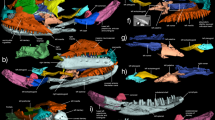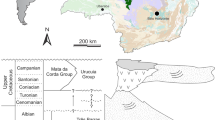Abstract
Although viviparity is most often associated with mammals, roughly one fifth of extant squamate reptiles give birth to live young. Phylogenetic analyses indicate that the trait evolved more than 100 times within Squamata, a frequency greater than that of all other vertebrate clades combined. However, there is debate as to the antiquity of the trait and, until now, the only direct fossil evidence of squamate viviparity was in Late Cretaceous mosasauroids, specialised marine lizards without modern equivalents. Here, we document viviparity in a specimen of a more generalised lizard, Yabeinosaurus, from the Early Cretaceous of China. The gravid female contains more than 15 young at a level of skeletal development corresponding to that of late embryos of living viviparous lizards. This specimen documents the first occurrence of viviparity in a fossil reptile that was largely terrestrial in life, and extends the temporal distribution of the trait in squamates by at least 30 Ma. As Yabeinosaurus occupies a relatively basal position within crown-group squamates, it suggests that the anatomical and physiological preconditions for viviparity arose early within Squamata.




Similar content being viewed by others
References
Bell GL, Sheldon MA, Lamb JP, Martin JF (1996) The first direct evidence of live birth in Mosasauridae (Squamata): exceptional preservation in the Cretaceous Pierre Shale of South Dakota. J Vertebr Paleontol Suppl 16:21A–22B
Blackburn DG (2000) Reptilian viviparity: past research, future directions, and appropriate models. Comp Biochem Physiol A 127:391–409. doi:10.1016/S1095-6433[00]00272-5
Blackburn DG (2006) Squamate reptiles as model organisms for the evolution of viviparity. Herpetol Monogr 20:131–146
Caldwell MW, Lee MSY (2001) Live birth in Cretaceous marine lizards (mosasauroids). Proc R Soc B 268:2397–2401. doi:10.1098/rspb.2001.1796
Cheng YN, Wu XC, Ji Q (2004) Triassic marine reptiles gave birth to live young. Nat 432:383–386. doi:10.1038/nature03050
Conrad JL (2008) Phylogeny and systematics of Squamata (Reptilia) based on morphology. Bull Am Mus Nat Hist 310:1–182. doi:10.1206/310.1
Davis AR, Corl A, Surget-Groba Y, Sinervo B (2011) Convergent evolution of kin-based sociality in a lizard. Proc R Soc B 278:1507–1514. doi:10.1098/rspb.2010.1703
Delfino M, Sánchez-Villagra MR (2010) A survey of the rock record of reptilian ontogeny. Semin Cell Dev Biol 21:432–440. doi:10.1016/j.semcdb.2009.11.007
Dufaure JP, Hubert J (1961) Table de developpement du lizard vivipara:Lacerta (Zootoca) vivipara Jacquin. Arch Anat Microsc Morphol Exp 50:309–328
Endo R, Shikama T (1942) Mesozoic reptilian fauna in the Jehol mountainland, Manchoukuo. Bull CentNat Mus Manchoukuo 3:1–19
Evans SE, Wang Y, Li C (2005) The Early Cretaceous lizard genus Yabeinosaurus from China: resolving an enigma. J Syst Palaeontol 3:319–335. doi:10.1017/S1477201905001641
He H, Wang X, Zhou Z, Wang F, Boven A, Shi G, Zhu R (2004) Timing of the Jiufotang Formation (Jehol Group) in Liaoning, northeastern China and its implications. Geophys Res Lett 31:L12605. doi:10.1029/2004GL019790
Hugi J, Mitgutsch C, Sánchez-Villagra MR (2010) Chondrogenic and ossification patterns and sequences in White’s skink Liopholis whitii (Scincidae, Reptilia). Zoosyst Evol 86:21–32. doi:10.1002/zoos.200900011
Ji S, Lu LW, Bo HC (2001) New material of Yabeinosaurus tenuis (Lacertilia). Land and Resources 2001(3):41–43, In Chinese
Ji Q, Wu XC, Cheng YN (2010) Cretaceous choristoderan reptiles gave birth to live young. Naturwiss 97:423–428. doi:10.1007/s00114-010-0654-2
Lee MSY, Shine R (1998) Reptilian viviparity and Dollo’s Law. Evol 52:1441–1450
Maisano JA (2001) A survey of state of ossification in neonatal squamates. Herpetol Monogr 15:135–157
Mattison C (1992) Lizards of the world. Blandford, London
Maxwell EE, Caldwell MW (2003) First record of live birth in Cretaceous ichthyosaurs: closing an 80 million year gap. Proc R Soc Lond B 270(Suppl 1):S104–S107. doi:10.1098/rsbl.2003.0029
Organ CL, Janes DE, Meade A, Pagel M (2009) Genotypic sex determination enabled adaptive radiations of extinct marine reptiles. Nat 461:389–392. doi:10.1038/nature08350
Renesto S, Lombardo C, Tintori A, Danini G (2003) Nothosaurid embryos from the Middle Triassic of Northern Italy: an insight into the viviparity of nothosaurs? J Vertebr Paleontol 23:957–960. doi:10.1671/1840-21
Rieppel O (1992) Studies on skeleton formation in reptiles. III. Patterns of ossification in the skeleton of Lacerta vivipara Jacquin (Reptilia, Squamata). Fieldiana (Zool) 68:1–25
Rieppel O (1994) Studies on skeleton formation in reptiles. Patterns of ossification in the skeleton of Lacerta agilis exigua Eichwald (Reptilia, Squamata). J Herpetol 28:145–153
Robert KA, Thompson MB (2010) Viviparity and temperature dependent sex determination. Sex Develop 4:119–128. doi:10.1159/000260373
Schulte JA II, Moreno-Roark F (2010) Live birth among iguanian lizards predates Pliocene–Pleistocene glaciations. Biol Lett 6:216–218. doi:10.1098/rsbl.2009.0707
Shine R (1985) The evolution of viviparity in reptiles: an ecological analysis. In: Gans C, Billet F (eds) Biology of the Reptilia, vol. 15. Wiley, New York, pp 605–694
Swisher CC III, Wang YQ, Wang XL, Xu X, Wang Y (1999) Cretaceous age for the feathered dinosaurs of Liaoning, China. Nat 400:58–61
Wang XL, Zhou ZH (2003) Mesozoic Pompei. In: Chang MM, Cheng PJ, Wang YQ, Wang Y (eds) The Jehol Biota. Shanghai Scientific and Technical, China, pp 19–35
Wang XL, Miao D, Zhang YG (2005) Cannibalism in a semi-aquatic reptile from the Early Cretaceous of China. Chin Sci Bull 50:282–284. doi:10.1007/bf02897540
Wapstra E, Olsson M, Shine R, Edwards A, Swain R, Joss JMP (2004) Maternal basking behaviour determines offspring sex in a viviparous reptile. Proc R Soc B Suppl 271:S230–S252. doi:10.1098/rsbl.2003.0152
Zhou Z (2006) Evolutionary radiation of the Jehol Biota: chronological and ecological perspectives. Geol J 41:377–393
Zhou Z, Zhang F, Li Z (2010) A new Lower Cretaceous bird from China and tooth reduction in early avian evolution. Proc R Soc B 277:219–227. doi:10.1098/rspb.2009.0885
Acknowledgements
This work formed part of a joint Anglo-Chinese project funded by the Royal Society, London and the National Natural Science Foundation of China. Field work was also supported by grant 41072015 from the NNSF, China. Our thanks go to Jie Zhang (IVPP) for photographing the fossil and to Jack Conrad, Marcelo Sánchez-Villagra and an anonymous reviewer for comments on an earlier draft.
Author information
Authors and Affiliations
Corresponding author
Additional information
Communicated by: Robert Reisz
Electronic supplementary material
Below is the link to the electronic supplementary material.
ESM 1
(PDF 181 kb)
Rights and permissions
About this article
Cite this article
Wang, Y., Evans, S.E. A gravid lizard from the Cretaceous of China and the early history of squamate viviparity. Naturwissenschaften 98, 739 (2011). https://doi.org/10.1007/s00114-011-0820-1
Received:
Revised:
Accepted:
Published:
DOI: https://doi.org/10.1007/s00114-011-0820-1




